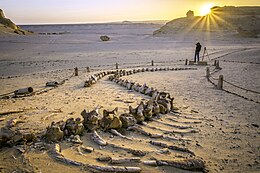This article needs additional citations for verification. (July 2021) |
| UNESCO World Heritage Site | |
|---|---|
 Basilosaurid whale skeleton in Wādī al-Ḥītān | |
| Location | Faiyum Governorate, Egypt |
| Reference | 1186 |
| Inscription | 2005 (29th Session) |
| Area | 200.15 km2 (49,458 acres) |
| Buffer zone | 58.85 km2 (14,542 acres) |
| Coordinates | 29°20′N 30°11′E / 29.333°N 30.183°E |
Wādī al-Ḥītān (Arabic: وادي الحيتان, lit. 'Wadi of the Whales' Egyptian Arabic pronunciation: [ˈwa.diː elˈħit.æːn] ) is a paleontological site in the Faiyum Governorate of Egypt, some 150 kilometres (93 mi) south-west of Cairo.[1] It was designated a UNESCO World Heritage Site[2] in July 2005[3] for its hundreds of fossils of some of the earliest forms of whale, the archaeoceti (a now extinct sub-order of whales). The site reveals evidence for the explanation of one of the greatest mysteries of the evolution of whales: the emergence of the whale as an ocean-going mammal from a previous life as a land-based animal.[4]
No other place in the world yields the number, concentration and quality of such fossils, nor their accessibility and setting in an attractive and protected landscape.[5] The valley was therefore inscribed on the UNESCO World Heritage List in 2005.[2]
- ^ "Wadi El Hitan (Whale Valley)". World Heritage Site for World Heritage Travellers. Retrieved 20 March 2022.
- ^ a b "Wadi Al-Hitan (Whale Valley)". UNESCO World Heritage Centre. United Nations Educational, Scientific, and Cultural Organization. Retrieved 20 July 2006.
- ^ "Africa World Heritage sites named". BBC News. BBC. 15 July 2005. Retrieved 20 March 2022.
- ^ "Wadi Al-Hitan Whale Valley | Whizzed Net". www.whizzed.net. 23 March 2023. Retrieved 2023-04-01.
- ^ United Nations Environment Programme World Conservation Monitoring Centre (Content Partner); McGinley, Mark (25 October 2007). Cleveland, Cutler J. (ed.). "Wadi Al-Hitan (Whale Valley), Egypt". Encyclopedia of Earth. Environmental Information Coalition, National Council for Science and the Environment. Archived from the original on 28 October 2007. Retrieved 20 March 2022.
